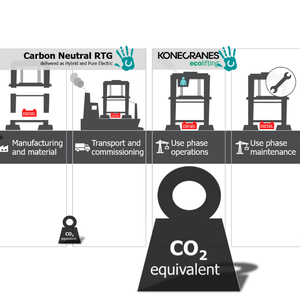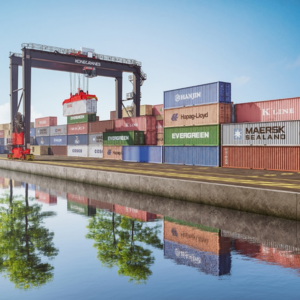As global concern about carbon emissions and climate change grows, Konecranes is taking significant action to reduce the CO2 emissions of its own operations and the carbon footprint of its products. As a world first in the container handling industry, Konecranes now delivers hybrid and electric RTGs to customers as carbon neutral. Carbon emissions have been minimized wherever possible, and where not possible they have been compensated for with re-forestation, up to the point of hand-over to the customer.
Konecranes is in a unique position to help our customers grow into a low carbon future by providing solutions which strengthen decarbonization and advance electrification, while we decrease the emissions of our own operations and our value chain. We design our products with their complete lifecycle in mind. The majority of the environmental impact of a product is defined during the product design stage. Therefore, we carefully analyze our product lifecycle phases in terms of the total carbon footprint. The lifecycle of our RTGs has three distinct phases: manufacturing and material, transport and commissioning; use phase; end-of-life.
Delivering RTGs to our customers in a carbon neutral manner concerns phase 1, which represents around 1/10 of the total CO2 load. Konecranes has worked determinedly and systematically to reduce the CO2 footprint of manufacturing, materials, transportation and commissioning. For the parts where we cannot eliminate all carbon emissions, we have compensated for it by means of a re-forestation scheme.
The usage of the equipment represents the main part of the carbon footprint of the RTG lifecycle – around 9/10. For this part Konecranes already provides many ways to reduce the carbon footprint with Ecolifting™ power options. In the end-of-life phase, the RTG steel structure can be fully recycled – this phase represents less than 1/10 of the total carbon footprint.
Mika Mahlberg, EVP of Konecranes Port Solutions, said: “This is a journey that benefits everyone. In the RTG lifecycle, there are many carbon dimensions to consider. We have done thorough research and detailed lifecycle assessment calculations. The objective was always clear: to deliver hybrid and electric RTGs to the customer in a carbon neutral state, so customers can operate their terminals with a bare minimum of climate impact, supporting their own long-term sustainability mission. This now comes as standard with hybrid and electric Konecranes RTGs. The customer doesn’t have to do anything.”
A strong focus on customers and commitment to business growth and continuous improvement make Konecranes a lifting industry leader. This is underpinned by investments in digitalization and technology, plus our work to make material flows more efficient with solutions that decarbonize the economy and advance circularity and safety.
For more information about Konecranes, RTGs delivered carbon neutral, and our Ecolifting™ offering please visit www.konecranes.com/ecolifting.
For more information:
Thomas Gylling, Director of Marketing and Customer Experience, Konecranes Port Solutions
Email: [email protected] or phone: +358405264343
Further information for investors and analysts:
Kiira Fröberg, Vice President, Investor Relations, Konecranes
Email: [email protected] or phone: +358204272050
For a concise overview of Konecranes’ business, please click here. And for a useful glossary of crane and crane-related terms, please click here.
Konecranes is a world-leading group of Lifting Businesses™, serving a broad range of customers, including manufacturing and process industries, shipyards, ports and terminals. Konecranes provides productivity enhancing lifting solutions as well as services for lifting equipment of all makes. In 2020, Group sales totaled EUR 3.2 billion. The Group has around 16,500 employees in 50 countries. Konecranes shares are listed on the Nasdaq Helsinki (symbol: KCR).

